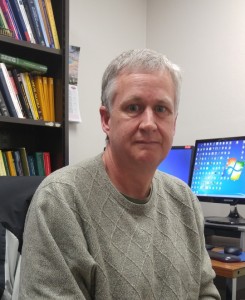Statistics professor earns prestigious award, will present lecture this fall
Encouraging greater skepticism of the validity of scientific results and greater experimentation are key ideas statistics professor Andrew Neath would like to stress in collegiate classrooms. Neath would like to change the way academics view experimental results.

Dr. Andrew Neath, Statistics professor won the William and Margaret Going Endowed Professorship Award on Feb. 17. (Photo by Joseph Lacdan)
He will have that opportunity to share his ideas having earned the annual College of Arts and Science’s William and Margaret Going Endowed Professorship Award on Feb. 17.
In addition to receiving a $5,000 research stipend, Dr. Neath will host a lecture this fall based on his current research on the topic, titled “The Replication Crisis in Science: A Statistical Perspective.”
“Right from the first statistics class, start to frame things in a way that is more in the language of uncertainty rather than in the language of once we’ve seen the experimental result that’s taken to be fact because we’re seeing, but that’s just not the case,” Dr. Neath said. “More experimentation is necessary, but that’s not always going to be possible. What should show is a bit more skepticism till we get greater experimentation.”
Neath’s research focuses on how to take experimental results as a whole, instead of trying measure evidence across a broad array of individual experimental results. To quantify this understanding of how to combine experimental results, Neath argues that more experimentation will lead to more accurate experimental results, but that may not always be possible. Instead, Neath encourages students and academics to frame their view of experimental results and question their validity.
Neath serves as advisor to senior and master’s statistics students and has helped students meet graduation requirements. Neath teaches stats for Biology, engineering and core statistics environmental sciences students, as well as calculus courses. He said in each course he tries to stress these concepts.
“I take it as a challenge each time I teach a course to go beyond what’s being presented in the textbook,” Neath said. “Because as I mentioned, part of the problem is how things are being presented in the textbook way. They want to make it as simple and as clean as possible. And in fact that’s leading to greater problems down the road when the real world isn’t clean and simple. The real world is filled with uncertainty. And if the training that we’re giving to users of statistics is that things come out clean and simple, then there’s concern as in the replication problem when things don’t match and when things aren’t always the same.”
“We teach statistics much more like a math class. We teach it based on said data, everybody should reach the same conclusion,” Neath said. “That conclusion should be stated with a strong degree of certainty. Well that just doesn’t hold in the real world. That just doesn’t hold because there is randomness involved in experimental results. So from that view, it shouldn’t all be surprising that just based on randomness sometimes we see something to that effect that constitutes randomness that would show evidence, sometimes we don’t. So the real key is to understand that experimental results doesn’t in of itself provide strong belief; experimental results only provides evidence.”
Neath said his lecture will apply to a wide variety of disciplines, as statistical experiments can be used in the medical fields and in the courtroom. The professor added that his lecture in the fall will appeal to a diverse audience and will invite people from surrounding communities to attend the lecture.
Last summer, Neath presented his research at the American Statistical Association in Alexandria, Va. and also had an article published by the ASA, where Neath gave an alternative definition of the P Value, a commonly used value in statistics used as a means to measure evidence against a hypothesis. Neath said the paper explores which models are best suited for prediction. Neath also published an article in the academic journal Computational Statistics in 2015.
Filed Under: Mathematics & Statistics












